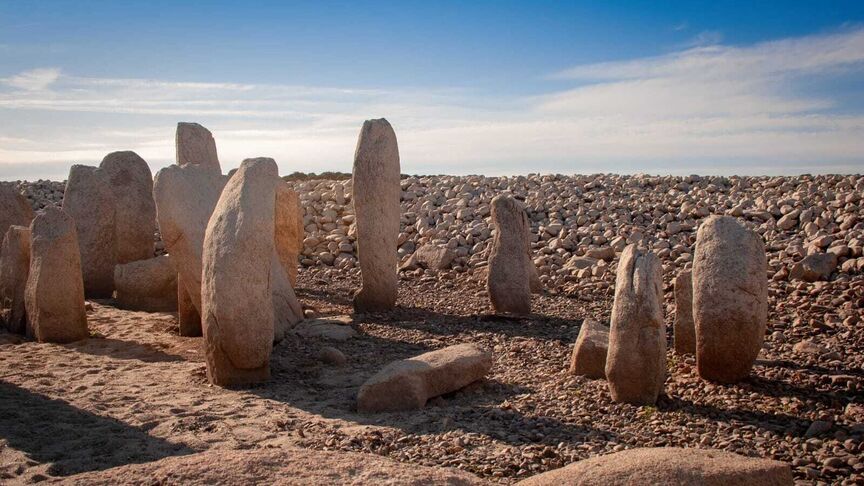Drought Reveals Dolmen of Guadalperal, Popularly Dubbed ‘Spanish Stonehenge’
Construction of a dam and reservoir in 1963 flooded the archaeological site, submerging the megalith monument and hiding it from view
/https://tf-cmsv2-smithsonianmag-media.s3.amazonaws.com/filer/4b/8b/4b8bca41-5a30-4ccb-ab97-fe3f119e4056/caceres_-provincia-yacimientos_arqueologicos-arqueologia-patrimonio_historico-patrimonio_423218916_132683733_1706x960.jpg)
In 1963, the Dolmen of Guadalperal—a megalithic monument raised in the city of Cáceres, Spain, around 4,000 to 7,000 years ago—vanished from view. Nearly 60 years later, local news outlets report, the landmark widely known as “Spanish Stonehenge” has reemerged, freed from submersion in the Valdecañas Reservoir by an unusually severe drought season.
“All my life, people had told me about the dolmen,” Angel Castaño, resident of a nearby village and president of the local Raíces de Peralêda cultural association, tells Atlas Obscura’s Alyssa McMurtry. “I had seen parts of it peeking out from the water before, but this is the first time I’ve seen it in full. It’s spectacular because you can appreciate the entire complex for the first time in decades.”
Still, the dolmen’s reappearance isn’t wholly positive: Per a Change.org petition calling for the monument’s preservation, the granite stones that dot the archaeological site are highly porous. Some show signs of erosion or have fallen over; others are already cracking. Cultural preservationists are calling to move the megaliths to a new location on dry land. “If we don’t act now,” Castaño warns in another interview with Local’s Fiona Govan, “it could be too late.”
According to David Barreira of El Español, the Dolmen of Guadalperal consists of about 140 boulders arranged in a concentric circle. Likely used as both a temple and cemetery, the monument once featured menhirs, or tall upright stones, topped by horizontal slabs of stone to form an enclosed dolmen, which is a single-chambered tomb. An engraved menhir stood guard at the structure’s entrance, while a pebble wall later built around the dolmen cemented its status as a collective burial site.
“Like Stonehenge, [the megaliths] formed a sun temple and burial ground,” Castaño tells Govan. “They seemed to have a religious but also economic purpose, being at one of the few points of the river where it was possible to cross, so it was a sort of trading hub.”

Experts are divided on the nature of one megalith engraving, Euronews’ Marta Rodriguez Martinez reports. While Castaño suggests a curvy line seen on the menhir refers to the winding route of the nearby Tagus River, archaeologist Primitiva Bueno Ramírez identifies the marking as a snake with a triangular head. (Speaking with Mario Adell of Spanish broadcasting station RTVE, Castaño adds that if confirmed as an early example of cartography, the engraving would represent one of the “oldest realistic physical maps in the world.”)
A German researcher named Hugo Obermaier first excavated the dolmen between 1925 and 1927. Although he sent unearthed artifacts back to his home country for study and exhibition, as David Vigario explains for El Mundo, Obermaier left the enormous stones in place, preserving as much of the monument’s original structure as possible. Based on the discovery of a Roman coin at the site, the scholar posited that it had previously been sacked by invading imperial forces.
Obermaier’s research remained unpublished until 1960. Three years later, a civil engineering project ordered by Francisco Franco’s regime brought a dam and reservoir to the region, offering an economic boon but submerging the dolmen underwater. Crucially, Ramirez tells McMurtry of Atlas Obscura, Guadalperal was far from the only archaeological site impacted by the dictator’s modernizing agenda. “You couldn’t believe how many authentic archaeological and historic gems are submerged under Spain’s man-made lakes,” Ramirez adds.
Unfortunately, an influx of visitors eager to explore the dolmen while it remains accessible has currently placed the prehistoric monument at greater risk, Mónica Arrizabalaga of Spanish daily ABC reports. There is no surveillance at the site, leaving tourists free to interact with—and likely damage—the megaliths. As Miguel Ángel Marcos adds for the newspaper Hoy, the trip to the dolmen is punishing, requiring visitors to walk for hours in the full heat of the sun.
The site’s immediate fate remains uncertain: The Ministry of Culture must decide whether to leave the structure as is, allowing the Valdecañas Reservoir to flood the monument once again, or relocate the rocks to a new home, as Castaño and Raíces de Peralêda urge.
/https://tf-cmsv2-smithsonianmag-media.s3.amazonaws.com/accounts/headshot/mellon.png)
/https://tf-cmsv2-smithsonianmag-media.s3.amazonaws.com/accounts/headshot/mellon.png)